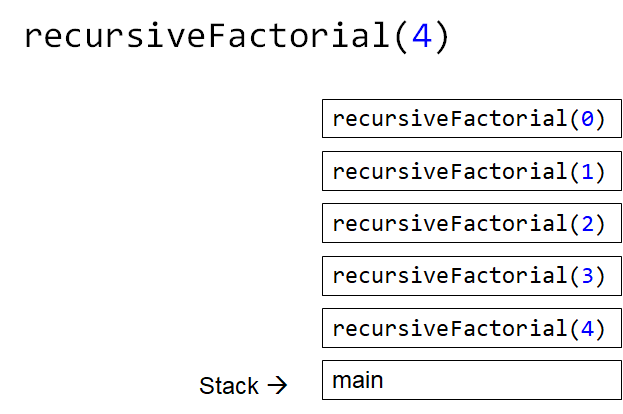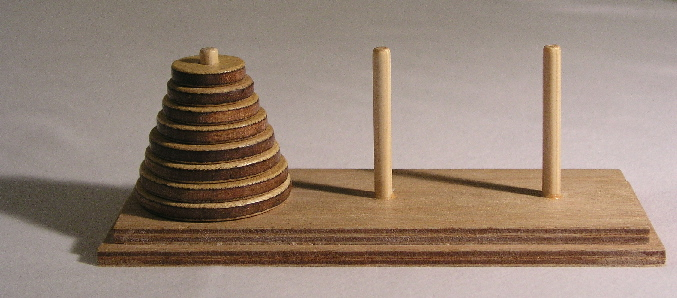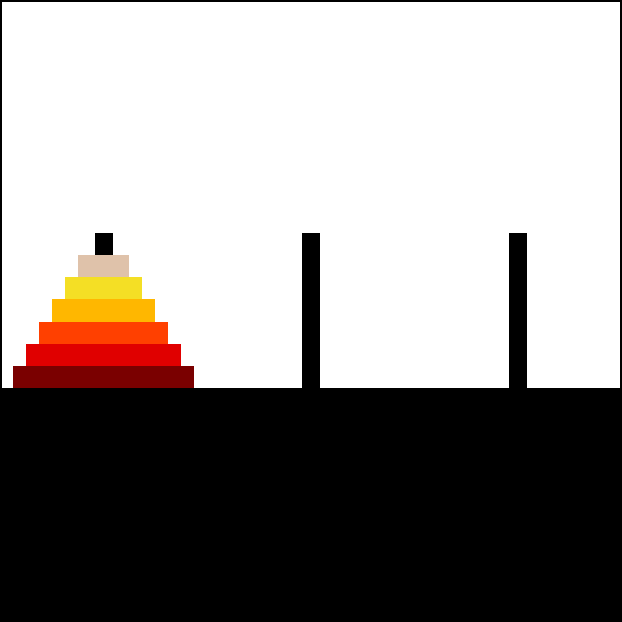22. Recursion

How many people are in this line?
How does one count them?
Just by looking at the first person, it’s exactly
1 +the number of people after the first person
22.1. Iterative Definition vs. Recursive Definition
Iterative definitions of things are fairly natural
Recursion on the other hand may feel a little less natural, but it pops up a lot in everyday life and in nature
22.1.1. Groups of People
Like the line of people example above, it may seem like a silly question because it is so intuitive
A group of people is:
2 people
OR 3 people
OR 4 people
OR …
…
…
Alternatively, the idea of recursion can be used to define a group of people a different way
When defining something recursively, the definition of something is used within its definition
Define something in terms of itself
A recursive definition of a group of people is:
2 people
OR a group of people plus one more person
Based on this recursive definition, if asked if 2 people are a group of people, the answer is clearly yes
It’s the first part of the recursive definition of a group of people
But if asked if 4 people is a group of people, some more digging is needed
In order to know if 4 people is a group of people, it needs to be known if 3 people is a group of people
If 3 is, then it can be concluded that 4 is since 4 is 3, a group of people, plus one more person
This is the second part of the recursive definition of a group of people
To know if 3 people is a group of people, it needs to be known if 2 people is a group of people
If 2 is, then it can be concluded that 3 is since 3 is 2, a group of people, plus one more person
By definition, 2 people is, in fact, a group of people
Therefore, 3 people is a group of people
Thus, 4 people is a group of people
In the above recursive example, notice a base case and a recursive case
The base case is something with a clear definition
The recursive case is one that defines something in terms of itself
Warning
Although there is no hard rule saying that a base case is needed, and there are examples of situations where it
would not be included, not including a base case is a recipe for disaster. Remember the uhOh() example from the
Memory & The Call Stack topic?
For the purposes of this course, always include a base case.
22.1.2. Lists
Think of a list from Python, or a linear linked structure
One can define this recursively in a rather natural way
A list is:
Base Case — An empty list
Recursive Case — There is a head of the list, followed by a tail — the remaining portion of the list
Consider the following list
[a, b, c, d, e]This can be broken down into the head
aand the tail[b, c, d, e]a + [b, c, d, e]The tail list can be broken down again and again until the empty list (base case) is hit
a + b + [c, d, e]a + b + c + [d, e]a + b + c + d + [e]a + b + c + d + e + []
22.2. Repeating Patterns
In counting example, it may feel like cheating by saying “1 + however many are after the front”
“however many are after the front” seems like skipping a step
But, with the list example, it was observed that repeatedly applying the same rule over and over on smaller and smaller lists resulted in hitting an end
The empty list
The base case
This pattern arises a lot with recursion — repeatedly apply the same rules on slightly different versions of the problem
As mentioned earlier, there is typically going to be a base case and a recursive case
In fact, there can be multiple base cases and recursive cases
Several examples of this will be seen when discussing trees
22.2.1. Going Up and Down
The set of natural numbers \(\mathbb{N}\) can be recursively defined as:
0 is a natural number
A natural number \(+ 1\) is a natural number
This recursive definition provides a complete definition of \(\mathbb{N}\)
One can start at the base case and repeatedly apply the recursive case to generate all natural numbers
This is a great way to mathematically define something infinite
Though, computers will not be all too happy with running this
One could also take this definition and use it to answer questions by working down to the base case, and then back up with the answer
Is \(4\) a natural number?
Is \(3 + 1\) a natural number?
Is \((2 + 1) + 1\) a natural number?
Is \(((1 + 1) + 1) + 1)\) a natural number?
Is \(((((0 + 1) + 1) + 1) + 1)\) a natural number?
\(0\) is a natural number
Therefore \(1\), which is \(0 + 1\), is a natural number
Therefore \(2\), which is \(1 + 1\), is a natural number
Therefore \(3\), which is \(2 + 1\), is a natural number
Therefore \(4\), which is \(3 + 1\), is a natural number
22.3. Recursive Programming
The factorial, \(n!\), of a non-negative integer is the product of all non-negative integers between \(n\) and \(1\) inclusively
It also includes zero, but this is addressed below
\(n! = n \times (n - 1) \times (n - 2) \times \dots \times 3 \times 2 \times 1\)
This can nicely be defined recursively
Note
Notice that \(0! = 1\). This is because:
It is \(1\) by definition (because someone said so), but this isn’t really a satisfying answer
\(1\) is the multiplicative identity, and it is used as the result when multiplying no factors
This is just like how adding nothing together results in \(0\) — the additive identity
It also aligns with the gamma function
If asked what \(4!\) is, it can be calculated by applying the rules; there are no real tricks to it
\(4! = 4 \times 3!\)
\(3! = 3 \times 2!\)
\(2! = 2 \times 1!\)
\(1! = 1 \times 0!\)
\(0! = 1\)
\(1! = 1 \times 0! = 1 \times 1 = 1\)
\(2! = 2 \times 1! = 2 \times 1 = 2\)
\(3! = 3 \times 2! = 3 \times 2 = 6\)
\(4! = 4 \times 3! = 4 \times 6 = 24\)
1static int iterativeFactorial(int n) {
2 int factorial = 1;
3 for (int i = 1; i <= n; i++) {
4 factorial = factorial * i;
5 }
6 return factorial;
7}
1static int recursiveFactorial(int n) {
2 if (n == 0) {
3 return 1;
4 }
5 return n * recursiveFactorial(n - 1);
6}
Both the iterative and recursive functions do the same thing
But, doesn’t the recursive function have a sort of beauty to it?
When considering the call stack, the stack will grow until it hits the base case
Then, each call frame will return the product to the calling function
Regardless of if the calling function is
recursiveFactorialormain

Example call stack of calling recursiveFactorial(4) when the program is currently executing the base case —
when n is 0. This is the state of the call stack before any values have been returned by any call frames.
22.4. Some Observations
Notice how
recursiveFactorial(4)makes a call torecursiveFactorial(3)If
recursiveFactorial(5)was called, it would need to calculaterecursiveFactorial(4)againIn other words, to know
recursiveFactorial(x), an answer torecursiveFactorial(x - 1),recursiveFactorial(x - 2), …recursiveFactorial(1), andrecursiveFactorial(0)must be calculatedOne many also notice the relationship between the
StackADT and the call stackAdditionally, anything that can be done with iteration can be done with recursion, and vice versa
However, just because it can doesn’t mean it should
Based on the design of the computational systems used, recursion creates additional overhead that slows things down
Creating call frames
Pushing/popping from the call stack
In some programming languages, like Java, compilers will optimize certain types of recursive functions by translating them to an iterative version
This does not mean, however, that one should not use recursion as sometimes recursive implementations are elegant and easier to write and understand
Simplicity of code may be tradeoff — remember, sometimes good enough is good enough
If performance needs improving later, do that later
Warning
The computers we as humans use are one type of computational system, and although recursion often ends up being slower than iteration on these computational systems, this is due to how the computational systems operate. Recursion is not intrinsically a slower process when compared to iteration.
22.5. Computational Complexity
When analysing code, it is important to think about many operations will be needed relative to an input size
nFurther, it is important to think about how much the amount of work done scales as
nchangesWhen looking at
iterativeFactorial(n)There are a few constant time operations (do not depend on
n)There is a loop doing constant time work that runs
ntimesTherefore, \(O(n)\)
When analyzing recursive functions, the idea is the same
How many operations will be needed relative to an input size
nHow much the amount of work done scales as
nchanges
When looking at
recursiveFactorial(n)There are constant time operations
There is a recursive call, which means the code inside this function can run repeatedly
The question then is, how many times will
recursiveFactorial(n)get called?
Accumulative times run |
Function call |
|---|---|
\(1\) |
|
\(2\) |
|
\(3\) |
|
\(\dots\) |
|
\(n - 1\) |
|
\(n\) |
|
\(n + 1\) |
|
With input
n,recursiveFactorialruns a total of \(n + 1\) times — \(O(n)\)It’s linear
22.5.1. Fibonacci
Consider the Fibonacci numbers
If not familiar with this sequence, try to figure out how it is created
\(0, 1, 1, 2, 3, 5, 8, 13, 21, 34, 55, 89, 144, 233, 377, 610, 987, 1597, 2584, 4181, 6765, ...\)
Here’s a hint
\(0, 1\)
\(0, 1, 1\)
\(0, 1, 1, 2\)
\(0, 1, 1, 2, 3\)
\(0, 1, 1, 2, 3, 5\)
\(0, 1, 1, 2, 3, 5, 8\)
\(0, 1, 1, 2, 3, 5, 8, 13\)
\(\dots\)
To generate this sequence, start with \(0, 1\), then to get the subsequent number, add the proceeding two together
1static int iterativeFibonacci(int n) {
2 if (n == 0) {
3 return 0;
4 }
5 int previous = 0;
6 int current = 1;
7 int next = 0;
8 for (int i = 2; i <= n; i++) {
9 next = current + previous;
10 previous = current;
11 current = next;
12 }
13 return current;
14}
What is the computational complexity of
iterativeFibonacci(n)?\(O(n)\)
The recursive definition of the Fibonacci numbers is quite elegant
1static int recursiveFibonacci(int n) {
2 if (n == 0 || n == 1) {
3 return n;
4 }
5 return recursiveFibonacci(n - 1) + recursiveFibonacci(n - 2);
6}
What is the computational complexity of
recursiveFibonacci(n)?This may feel a little less straight forward compared to
recursiveFactorial(n), but the idea is the sameThe function has constant time operations
But there are recursive calls, so, how many times does this function get called?

Visualization of the recursive function calls when calling recursiveFibonacci(6). Unless it is the base case,
each call to recursiveFibonacci produces two more recursive calls to recursiveFibonacci. Notice how many
times recursiveFibonacci(2) is calculated — 5.
When analyzing factorial (not Fibonacci), it was observed that each function call made one or zero recursive calls
There was
1recursive call for each of thenvalues between1–nThere was no recursive call in the base case
When looking at
recursiveFibonacci(n), how many potential recursive calls are there for each of thenvalues?Two
Each new call will call two more, which will call two more, which will call two more…
\(1\)
\(2\)
\(4\)
\(8\)
\(16\)
\(32\)
\(64\)
\(\dots\)
This patten follows \(2^{n}\)
Roughly speaking, the number of recursive function calls doubles each step
In other words, this recursive implementation is \(O(2^{n})\)
If given the choice between something that grows linearly or something that grows exponentially, take the linear
Despite the simple elegance of the recursive fibonacci implementation, this would be a good example of going back and improving the implementation for better performance
To get a sense of why the recursive version is so much worse than the iterative
Look at the above figure for a hint
When calculating
recursiveFibonacci(6),recursiveFibonacci(2)is calculated a total of \(5\) timesThe iterative implementation would have only calculated this once
22.6. Towers of Hanoi
Given
Three pegs
Several disks that can be added or removed from the pegs
All disks vary in size
All disks start on one peg with the largest at the bottom and the smallest at the top
The goal is to move all disks from one peg to another with the following constraints
Only one disk can move at a time
A disk may never be placed on top of any smaller disk
All disks must be on some peg at all times, with the exception of the one currently being moved

Example Towers of Hanoi puzzle.

Animation of Towers of Hanoi being solved.
Towers of Hanoi is a classic example of where a recursive function is beautifully succinct
The trick is to consider that, whenever moving a disk, there is a source peg, a destination peg, and an extra peg
Further, what is considered the source, destination, and extra peg is relative to when and what disk is being moved
Equipped with this information, to move \(n\) disks from the source to the destination, simply
Move the \(n - 1\) disks from source peg to the extra peg
Move the \(n^{th}\) disk to the destination peg
Move the \(n - 1\) disks from the extra peg to the destination peg
Steps 1 and 3 may feel like cheating, but notice that they are actually recursive calls
Also, what one considers the source, destination, and extra peg will change when moving the \(n - 1\) disks
Looking at the first step, it says move the \(n - 1\) disks from source peg to the extra peg
Ok, how is that done?
Move the \((n - 1) - 1\) disks from source peg to the extra peg
Move the \((n - 1)^{th}\) disk from the source to the destination
Move the \((n - 1) - 1\) disks from extra peg to the destination peg
But, the extra and destination pegs are different for the \((n - 1)\) disks
The extra peg when moving \(n\) disks has become the destination peg when moving \((n - 1)\)
Similarly, the destination peg when moving \(n\) disks is this recursive step’s extra peg
Warning
This is a non-trivial problem and algorithm. If the ideas are difficult to grasp, don’t worry too much.
22.7. For Next Time
Read Chapter 8
28 pages